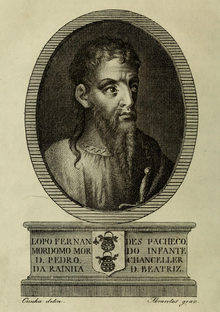|
Lopo Fernandes Pacheco
 Lopo Fernandes Pacheco (died 22 December 1349), was the first of his lineage to accede to the highest ranks of the nobility, that of a rico-homem, in the Kingdom of Portugal. He lived during the reign of King Afonso IV of Portugal of whom he was his favorite and loyal vassal.[1] His parents were João Fernandes Pacheco and his wife Estevaínha Lopes de Paiva, daughter of Lope Rodrigues de Paiva and Teresa Martins Xira.[2] His family owned properties in different parts of the kingdom although its area of influence was mainly Beira in the northern part of the country.[3] LifeThe rise of his lineage in the Kingdom of Portugal, a process by which members of the lower nobility gradually displaced the old lineages, began with Lopo Fernandes Pacheco, the first Lord of Ferreira de Aves.[4] A great favorite of the monarch, he was perhaps one of the most prominent personalities during the reign of Afonso IV of Portugal.[5] He occupied several posts in the kingdom: merino-mor (1329);[6] mordomo-mor of Infante Pedro, the future King Pedro I of Portugal; and, member of the king's council.[7] He was also the mordomo-mor (1334-1336) and chancellor (1349) of Queen Beatrice of Castile,[8] the wife of King Afonso IV, and, in 1327 was one of the executors of the will of Queen Elizabeth of Aragon, the wife of King Denis of Portugal.[9][7] King Afonso IV entrusted Lopo with the education of his children, the infantes Peter and Eleanor,[10] the future queen of Aragon by her marriage to King Peter IV. He appears in 1317 with Infante Afonso and in 1318 was one of the witnesses when Afonso made several donations to the Monastery of Saint Denis in Odivelas. He sided with Afonso against the pretensions of his half-brother, Afonso Sanches[10] and was at his side in 1322 when the brothers signed the peace treaty in Pombar.[1] King Afonso IV entrusted Lopo with several diplomatic missions as the ambassador to the Holy See and to the kingdoms of Castile and Aragon.[11] He was one of the forty nobles who were held hostage to ensure compliance with the Treaty of Ágreda, originally signed in 1304 and ratified in 1328 by King Alfonso IV and King Alfonso XI of Castile.[10] In 1340, Lopo was one of the many nobles who fought alongside the Portuguese king in the Battle of Río Salado in support of King Alfonso XI of Castile.[12] Due to his constant presence in the curia regis, most of his estates, purchased or donated by the King, were situated along the Tagus in the Santarém District as well as in Lisbon and surrounding areas. As compensation for his services to the royal family and for having raised two of the infantes, he received the lordship of Ferreira de Aves from King Alfonso IV "... and was raised by King Alfonso IV from his natural status as a knight to the category of rico-homem, jointly with his son Diogo Lopes Pacheco".[13]  Lopo Fernandes Pacheco died on 22 December 1349 and was buried in Lisbon Cathedral, also the final resting place of King Alfonso IV. His sarcophagus, one of the most beautiful ones in the cathedral, is in the Chapel of Saint Cosme and Saint Damian. The most relevant events of his life and his marriage were engraved on a stone slab, commissioned by King Afonso IV, which was placed on the wall above his sarcophagus.[14] Marriage and issue Lopo Fernandes Pacheco married twice. His first marriage was to Maria Gomes Taveira (died after 1331),[7] daughter of Gomes Lourenço Taveira and Catarina Martins.[15] They were the parents of:
By 1345 he was already married to his second spouse, María Rodríguez de Villalobos,[18][7] who was still alive in 1367 and was the daughter of the Leonese noble Ruy Gil de Villalobos (died 1307) and of Teresa Sánchez, an illegitimate daughter of King Sancho IV of Castile,[19] whose first husband was João Afonso Telo, 1st Count of Barcelos.[20] María Rodríguez de Villalobos was the executor of the will of her nephew João Afonso de Albuquerque.[21] The children of this marriage were:
References
Bibliography
External links |
||||||||||||||||
Portal di Ensiklopedia Dunia
